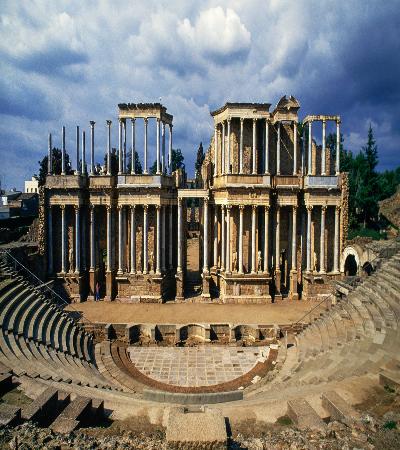 Mérida is a city in Spain that stretches on the banks of the Guadiana River, the capital of Extremadura and is part of the province of Badajoz. Has a population of 55,700 residents. The city is over two thousand years old and is famous for its architectural monuments of Ancient Rome. You can admire the majestic beauty and the unsurpassed power of the Roman era.
Mérida is a city in Spain that stretches on the banks of the Guadiana River, the capital of Extremadura and is part of the province of Badajoz. Has a population of 55,700 residents. The city is over two thousand years old and is famous for its architectural monuments of Ancient Rome. You can admire the majestic beauty and the unsurpassed power of the Roman era.
The city was founded before our era by the Roman emperor Octavius Augustus. Like many cities in Spain, Mérida combines characteristics from different eras: Roman rule, Arab conquests, and medieval chivalric culture. Historians have calculated that the city has preserved a large number of monuments of ancient Roman architecture, various statues, mosaics, and paintings, which are of the highest historical and cultural value to the general public. In December 1993, the city was declared a "World Heritage Site" by the Unesco world organization.
The Spanish city of Mérida was able to preserve a large number of ancient architectural monuments. The former settlement of Emerita Augusta is constantly undergoing excavations and investigations. All archaeological finds are transferred by historians to the National Museum of Roman Art, which was designed and built by the famous architect Rafael Moneo. Here you can see statues of gods and emperors, various types of mosaics, household items, jewelry and other cultural artifacts from the Roman era.
All the historical monuments of Mérida are under the protection of UNESCO. They also form a single site "Merida Archaeological Complex". At different times, restoration works have been carried out and are being carried out in the city. For example, the Roman theater was restored in the mid-20th century under the supervision of the architects Menendas Pidal and Melida. Invariably, a large number of tourists visit this unique oasis of the ancient Roman culture on Spanish soil.
Roman theatre:
The Roman Theater is one of the symbols of Mérida, a magnificent ancient monument built by Agripa in 16 B.C. and rebuilt in the 1st century AD. after a fire during Hadrian's reign. It is very well preserved and was perfectly restored. The theater is shaped like an ellipse. It could accommodate 6,000 spectators. The back wall of the stage buildings has magnificent sculptural decorations. In ancient times, behind them was a garden that served as a vestibule. The theater is still used for various cultural events and activities.
Nearby there is a museum of Roman art. It contains a magnificent collection of Roman antiquities found in Mérida: ancient coins, sculptures, glassware, ceramics, and tombstone wall paintings. The museum was built on archaeological sites and excavations are taking place in the basement.
Amphitheater:
The amphitheater is located next to the old theater. It was built in 15 B.C. and it had capacity for about 15,000 spectators. Gladiator fights were held here. After the ban on battles, the amphitheater was dismantled. Oddly enough, even sea battles were fought in his bowl. The stage could have been flooded with water, allowing small boats to sail. Next to the Roman amphitheater are the ruins of a Roman villa. On this site there are several rooms decorated with frescoes, mosaic corridors and a beautiful open space, the remains of the thermal baths.
The Merida Cathedral:
This is a cathedral built in the 13th century. Traditionally, the basilica was built on the site of the oldest religious buildings: it is located at the foundation of the Temple of the Gothic Conquerors of the West, which was built at the burial place of the early christians. An even older foundation under the same structure is an ancient Roman temple. These historical "capes" can be seen with your own eyes when you go down to the dungeon under the basilica, where there is a beautiful exhibition.
Roman aqueduct:
This bridge was built when the capital of the Roman province of Lusitania was in Mérida. The Guadiana is a river that runs along the border between Spain and Portugal. The bridge is 800 meters long and was built by order of the emperor Octavius Augustus in 25 B.C. A garrison of Roman legionaries was stationed to guard the bridge. This bridge is the longest that has survived in ancient times. It is used only as a pedestrian bridge. The Roman bridge is on the UNESCO World Heritage list.
National Museum of Roman Art:
Mérida is a very unusual Spanish city, which surprises with its number of architectural monuments. Worth a visit to immerse yourself in the era of gladiatorial battles and Roman emperors, walk on ancient bridges across no less ancient rivers. The city has everything for the comfortable stay of tourists. Many hotels, cafes and restaurants are ready to receive their visitors. Ancient history is full of every street in Merida, so you cannot miss the opportunity to live in this place at least for a time.
